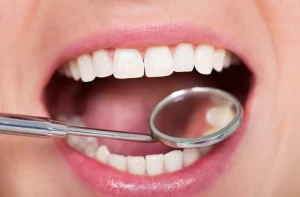How Dentists Clean Your Teeth
Dental cleanings play a crucial role in maintaining oral health and preventing cavities, gum disease, and bad breath. This process involves the removal of plaque, tartar, and other debris from the teeth and gums. Dentists and dental hygienists utilize a variety of tools and techniques to ensure a thorough and effective cleaning.
Our North East, PA, dental professionals offer insights into the dental tools and instruments used during teeth cleanings, along with the various techniques. For more information, contact our North East dental practice at (814) 725-4700.

Tools and Techniques Used for Dental Cleanings
Scaling and Root Planing
Scaling and root planing are essential for removing plaque and tartar buildup, especially for patients with early-stage gum disease. Scaling targets plaque above the gum line, while root planing smooths the teeth’s roots to prevent further plaque buildup. This dual approach helps reverse the effects of gum disease and promotes healthy gums.
Polishing Tool
After scaling, we use a polishing tool to smooth and shine your teeth’s surfaces. This step enhances your smile’s appearance and makes it harder for plaque and tartar to accumulate, preventing tooth decay and gum disease.
Dental Explorer
A dental explorer is a thin, pointed tool used to detect tooth decay, gum disease, and other oral health problems. Its flexible, angled tip allows dental professionals to probe hard-to-reach areas, ensuring no issue goes unnoticed.
Dental Scaler
Dental scalers are stainless steel tools designed to remove plaque and tartar from the teeth and below the gum line. Their hooked or curved tips allow dental hygienists to scrape away buildup that brushing and flossing can’t reach.
Ultrasonic Scaler
For faster and more efficient cleanings, we use ultrasonic scalers. These tools use high-frequency vibrations to break down plaque and tartar, reducing cleaning time while ensuring a thorough result.
Dental Mirrors
Dental mirrors are handheld tools used in dentistry to enhance the visibility of hard-to-see areas in the mouth, allowing dental hygienists to visualize these regions effectively. With angled heads and long handles, they enable dentists and hygienists to reflect light and examine the surfaces of teeth and gums. This aids in detecting problems and making accurate diagnoses during a dental exam.
Curette
A curette is a curved tool used to remove plaque and tartar from below the gum line. Its sharp, hook-like tip ensures even the deepest buildup is removed, preventing gum disease and maintaining healthy gums.
Suction Device
A suction device, also known as a dental suction or saliva ejector, removes saliva, water, and debris during dental procedures. This tool ensures a clean, dry environment, allowing dentists to work with precision and accuracy.
Dental Floss
Dental floss is a thin, waxed string used to remove plaque and food particles between teeth, helping to prevent tooth decay and gum disease. Dentists recommend flossing at least once a day for good oral hygiene. A dental professional can demonstrate proper flossing techniques during a cleaning.
Water Syringe
A water syringe rinses your mouth during and after cleaning, removing any remaining debris. It’s especially helpful for patients with braces or other dental appliances.
X-Rays
X-rays are a safe and painless way to detect hidden dental issues like cavities, bone loss, and impacted teeth. They’re an essential part of providing comprehensive oral care.

Frequently Asked Questions
Is a water syringe safe for sensitive teeth?
Yes, water syringes are generally safe for sensitive teeth. However, consult your dentist for personalized advice. They can advise you on the best way to use the syringe and any precautions you may need to take.
What’s the proper technique for using dental floss?
The proper technique for using dental floss involves wrapping the floss around your fingers and gently sliding it between each tooth, being careful not to snap it against the gums. Once the floss is between the teeth, curve it around each tooth in a C-shape and move it up and down to remove any plaque or food particles. Repeat this process for each tooth, using a fresh section of floss for each tooth.
Can I take a pain reliever before my dental cleaning appointment?
Yes, but consult your dentist first, especially if you have allergies or medical conditions. They may also provide alternative options to make the experience more comfortable, such as numbing gels or sedation.
What are the best dental tools?
There aren’t necessarily any best dental tools. The best dental tools will depend on the specific needs of the dental procedure being performed. Some of the most common dental instruments used are dental drills, mouth mirrors, dental scalers, and dental syringes.
Schedule Your Dental Cleaning in North East, PA Today!
At our North East dental practice, we’re committed to providing thorough and effective dental cleanings using the latest tools and techniques. Whether you’re in North East, Erie, Ripley, Findley Lake, or surrounding areas, we’re here to help you maintain a healthy and happy smile. Call us at (814) 725-4700 to book your appointment and take the first step toward optimal oral health!
 Pay My Bill
Pay My Bill